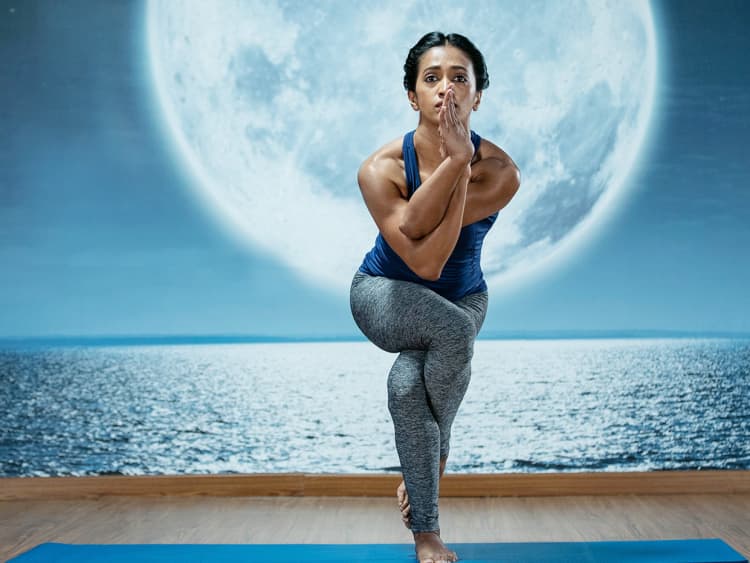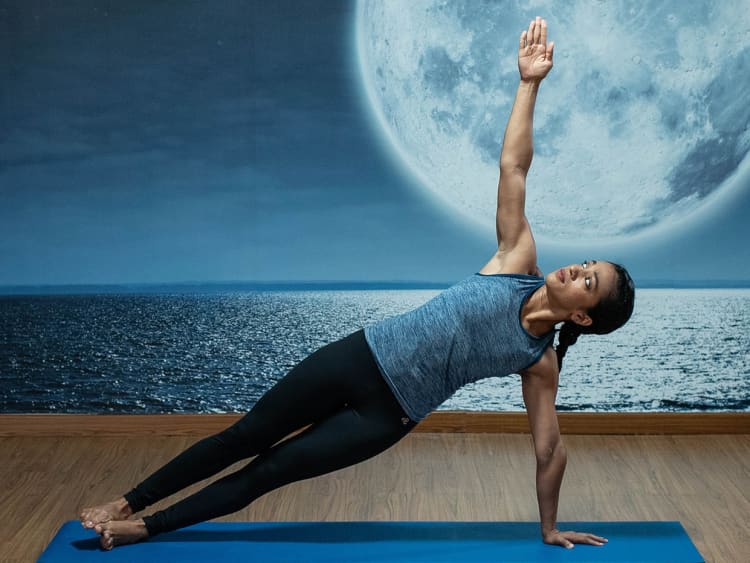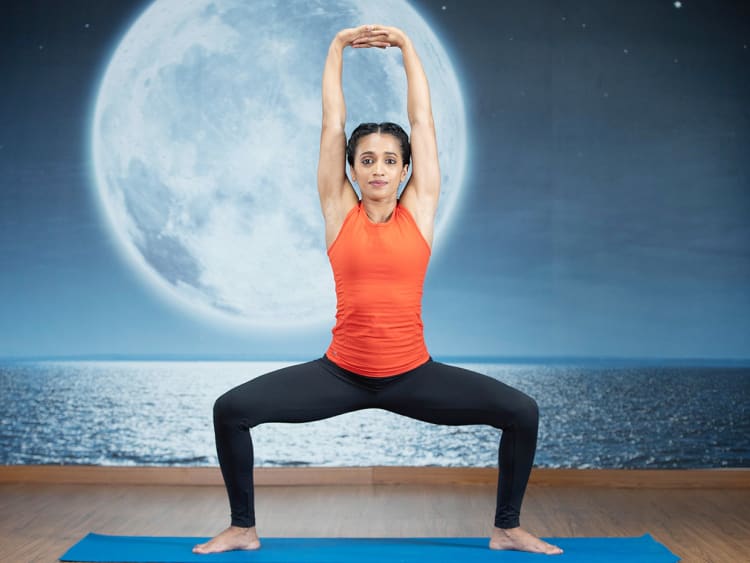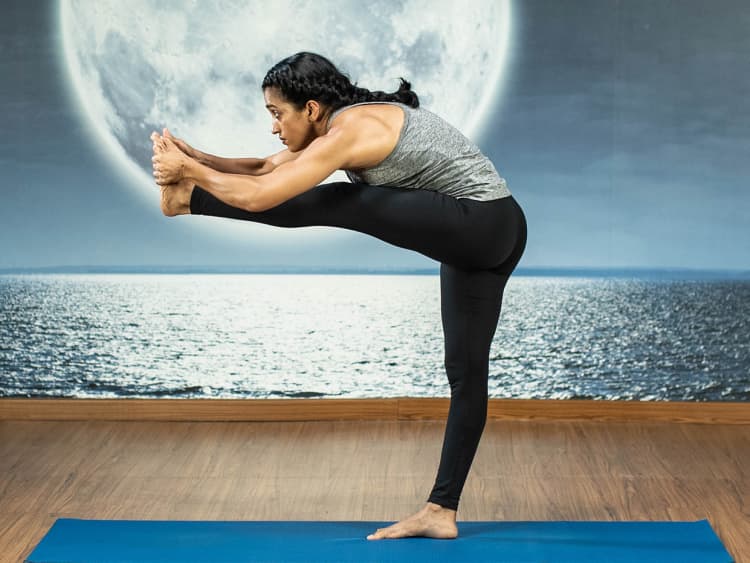Hatha Yoga
This hatha yoga series will focus on enhancing physical strength required for everyday activities.
Know more
Yoga Strength - 1
This series is an introduction to working on physical strength, with simple to follow instructions of some of the classical and popular asanas of Hatha yoga. The focus will be on realizing and enhancing physical strength that is required for our everyday activities.
Yoga Strength - 2
This series will focus on upper and lower body strength. The imbalance of strength in the upper and lower body is responsible for many injuries and undue stress in the weaker of the two.
Yoga Strength - 3
This series focuses on refinement of muscular engagement, meaning bringing in efficiency in the use of muscular energy utilised during practice. Along with muscular strength, we will work on the right recruitment of muscle, which prevents wear and tear and injuries to vital tissues.
Yoga Strength - 4
This series continues to work on strengthening the upper, lower and core area of the body. It covers a balance between strength and mobility.
What is Hatha Yoga?
There are many types of yoga. One of the most famous types is hatha yoga. It includes the use of body, mind, and breath. One session of hatha yoga usually lasts for 45 minutes to 90 minutes. Its yoga class usually includes various yoga asanas, meditation, and breathing practices.
The origin of yoga goes back to around 2,000 years ago in India. Back then, it started with a number of spiritual exercises that involved breathing. With time, yoga evolved in India into various and even travelled to other continents. Because of its efficiency, hatha yoga has now become popular all across the world.
How Effectively Can We Do Hatha Yoga at Home?
You can do hatha yoga at home very efficiently. In fact, some people find that they can do hatha yoga at home easily than at other places like a gym because they require silence and states of peace for doing it and that can be available in plenty at home.
Other than a peaceful environment, you also need proper guidance for doing hatha yoga. In the Internet age, you can easily get that within your budget.
Who Can Do Hatha Yoga?
Generally, experts tell that anyone with good health can practice hatha yoga asanas. All you require to do is some time and regular practice. However, certain things should be taken into consideration before starting it. You can do hatha yoga for beginners if:
You can stretch your body and limbs without stressing your muscles.
You can move your shoulder and limbs easily.
You don’t have any kind of spine or back injury.
Who Should Avoid Hatha Yoga?
Since hatha asanas require you to engage your body with strength and power, you need to make sure that you are not hurting your body in any way while doing that. You should completely avoid doing hatha yoga sequences in the following situations:
If you have any kind of Blood Pressure (BP) or Cardiac issues, avoid doing hatha asanas.
If you have had any kind of wrist, shoulder, or back injury in recent that has not healed completely, you should avoid doing hatha yoga sequences.
Pregnant ladies and those who recently have given birth should also not perform classical hatha yoga.
If you have any serious joint problems, avoid doing yoga for strength and flexibility as it can trigger pain.
Once your health condition changes, you can start doing yoga for flexibility and strength for beginners under the guidance of a yoga guru or a health expert.
What Are Some Types of Hatha Yoga?
There are various types of hatha yoga. But because there is no concrete boundary that separates a yoga pose from one type to another, these types are made only loosely. Here are a few types of hatha yoga:
Sitting yoga poses
Standing yoga poses
Inversion yoga poses
Under these types, you can perform the various yoga asanas. Some commons ones are:
Tadasana
Vrikshasana
Adho Mukha Svanasana
How to do Hatha Yoga?
To do a pose properly, you have to know all the hatha yoga steps in detail. So, here are some yoga strength asanas described step-by-step:
Tadasana
You should try Tadasna you want to do yoga for core strength. It is probably one of the easiest asanas present out there done for attaining yoga strength. It is especially good for beginners as in the start, their body is usually not prepared for doing complex asanas. Make sure that you do it only with an empty stomach as you should with almost every yoga for core strength.
Step-by-Step Guide
Stand with a straight spine, with both of your feet joined together.
Keep your thighs firm, you have to place your hands alongside your thighs.
Lift your kneecaps without hardening the lower part of your stomach
As you lift them, make sure that the arches of the inner ankles are straight.
Slowly, move the upper part of your thighs inward while stretching the tailbone towards the mat.
Try to pull your pubis towards your navel.
Meanwhile, focus on anything that is present at the level of your eyes for better focus.
While your stretch your both arms upwards, breathe in.
Hold your breath for 60 seconds (you can hold on for a lesser time if you are not comfortable) and exhale slowly.
Time: Hold the pose for at least 30 to 60 seconds.
Vrikshasana
Known as the tree pose in the English language, Vrikshasna is an easy yoga for back strength. Apart from the back, it also requires a stretch of your arms and legs. It brings equilibrium to your mind. But most importantly, it improves the coordination of your mind with your body. One thing that is common in every yoga for back strength, is that you have to maintain the right pose with patience. Without patience, you will lose the original form of the pose and the effectiveness of the yoga will reduce down significantly.
Step-by-Step Guide
Stand with a straight spine, with both of your feet joined together.
If you are standing comfortably, place your right foot exactly on the inside of your left thigh. Your sole should be placed firmly on the thigh root. Meanwhile, make sure that your left leg is straight and comfortable.
Make a nice balance in this position, take a slow breath, and gradually, raise arms over your head from both sides.
Join your palms to make a Namaste Mudra.
Meanwhile, focus on anything that is present at the level of your eyes for better focus.
Your body should be stretched and your spine should be straight. Take deep breaths and relax your body muscles
Bring down your both hands slowly and release the right leg from the thigh of the left leg.
Take a rest of a few seconds.
Now, use the left leg to place on the right thigh and repeat the whole process.
Time: Held the pose for at least 20 to 60 seconds. Increase the time as you get comfortable with the pose.
Adho Mukha Svanasana
Also known as the downward-facing dog pose, this is a very common asana that people can be seen doing in yoga parks. It is an important asana in yoga strength training. However, like the above-mentioned two asanas, it requires a certain level of flexibility and muscle stretching in the body. But, you can make that trade-off easily for yoga strength training.
Step-by-Step Guide
Get on all four limbs to make your body look like a table.
Make sure that your feet are aligned with your hips and your hands are aligned with your shoulders.
Lift your hips up while straightening your knees and elbows to make an inverted V shape with your body.
Press your hands on the mat and lengthen your neck.
Touch your ears to the inner arms.
Hold this ‘inverted V’ shaped pose for a couple of seconds.
Slowly, bend your knees, relax your body and come back to the pose from where you started.
Time: Held the pose for 60 seconds to 180 seconds at a stretch. Increase the time and repeat it as you get comfortable with the pose.
Benefits of Doing Hatha Yoga
The benefits of doing hatha yoga asanas are enormous. You can do hatha yoga for weight loss or you can do yoga for core strength. Doing hatha yoga on a regular basis can give you hundreds of desired results. Here is a list of some of the most important health benefits of performing hatha yoga:
Anxiety and depression: There is a popular myth that hatha yoga helps only in providing your physical strength. However, it is false and perpetrated only by people who have not tried doing yoga balance poses a single time in their life. There is now enough medical evidence that suggests that doing some specific hatha yoga asanas can actually help you in reducing anxiety, depression, and even PTSD.
Stamina: Running and going to the gym do increase your stamina, but if we say that you can easily do the same at your home by performing yoga for strength and stamina. There are many hatha yoga postures that can actually help you in improving your stamina.
Weight Loss: It is a no-brainer that you can also do hatha yoga for weight loss. There are various types of hatha yoga poses that especially emphasize burning your calories at a very high rate.
Upper Body Strength: Just like you can do certain exercises in the gym that specially focuses on your upper body, there are also certain types of yoga for upper body strength. If you want a perfect V-shaped upper body, try out doing some hatha yoga.
Flexibility and mobility: The modern lifestyle pushes people into sluggishness. However, you can do that by doing yoga for strength and flexibility. Taking out 30-45 minutes regularly for your body can give you result in real-time.
Mindfulness: In a life of constant hustle, mindfulness is what you need to neutralize every aspect. Doing hatha yoga in a silent space can help you with mindfulness.
Disadvantages of Doing Hatha Yoga
People talk about various advantages of doing hatha yoga but no one talks about its disadvantages. Well, that is because there are almost no disadvantages to it. In fact, if you do it carefully under the guidance of an expert, you will certainly not experience any disadvantage.
However, you should know about the disadvantages before you start doing hatha yoga for beginners as knowing them can make you more cautious. Here is a list of some possible disadvantages of doing hatha yoga:
If not done properly, you can lose your balance and that can lead to an injury.
Doing one type of hatha yoga, again and again, can put stress on any muscle.
Intense yoga exercises can cause pain in the body. So, if you have started doing it, try only doing hatha yoga for beginners.
Dos & Don’ts
To take all the benefits of hatha yoga asanas, you need to know all the things about it, and that also dos and don’ts. We have prepared two separate lists of dos and don’ts of hatha yoga, give them a quick read:
Do’s
Warm-up every time before doing yoga strength. It is necessary to prevent muscle spasms.
Try to eat complimenting food with hatha yoga. It can actually quicken the process of giving results.
Wear worn and loose clothing so that you stay comfortable while doing yoga. If you do not wear comfortable clothing, your focus will keep distracting from the point where it should ideally be.
Use a mat or a thick towel to form insulation between you and the earth. Actually, insulation is required to stop your body’s energy from passing on to the earth.
Try to always perform hatha yoga poses with a cleaned body. Actually, it can help with concentration and focus.
Try to find a lonely or peaceful place as you do not want others to distract you while you are focusing.
Maintain a buffer of at least two hours of the meal before or after doing hatha yoga.
Don’ts
Do not ever try to do inversion yoga poses with a full stomach. It can cause stomach pain, indigestion, and other types of medical conditions.
Do not drink cold water and shower at least for half an hour of a hatha yoga session.
Do not try to perform strenuous exercises immediately after doing the yoga. Take some rest and give time to your body muscle to release the stress or it can cause muscle spasms.
Do not perform the only type of hatha yoga as it can also put stress on some specific muscles of your body.
Things Required to Do Hatha Yoga if You Are at Home & Gym?
As we have mentioned earlier, doing hatha yoga requires does not require specialized equipment. It is done in a very simplistic manner with zero to little prerequisites. Here is a list of some basic things that you might want to keep handy for doing hatha yoga poses:
Comfortable clothes
Yoga mat
Water bottle
A clean towel
Cushion
Top Searches
Dentist Near Me | Gynaecologist Near Me | Dermatologist Near Me | Endocrinologist Near Me | Pulmonologist Near Me | Cardiologist Near Me | Orthopedist Doctor Near Me | Thyroid Test | Pregnancy Test | Full Body Checkup | Kidney Function Test | Therapist Near Me | Online Counselling | Physiotherapist Near Me





